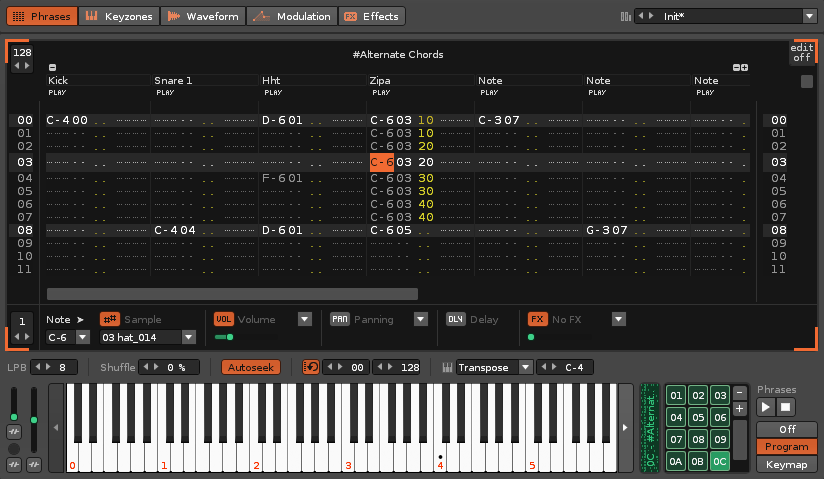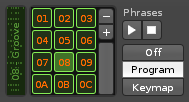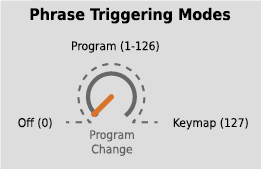Phrase Editor
Phrase Editor
With the Phrase Editor you can compose musical phrases that will be activated when specific notes are played. Phrases are created using a scaled-down version of the Renoise Pattern Editor, consisting of just a single track and pattern. While both Redux and Renoise use samples to create phrases, Renoise can also make use of the Plugin and MIDI components of an instrument.
Instruments are recorded by entering notes onto lines in the order that they are to be played, from top to bottom. This is done with the Tracker Interface, so if you're unfamiliar with this method of working, you should read through that section of the manual before continuing here. An instrument can feature up to 120 different phrases, one for each available key. Phrases are part of an instrument (.xrni) and so are loaded/saved along with any samples and other instrument data.
Phrases (.xrnz) can be loaded and saved as presets using the drop-down menu located at the top right corner.
Creating Phrases
If an instrument does not have an existing phrase then the ![]() button will need to be pressed.
button will need to be pressed.
While the Phrase Editor is open, notes played with the computer keyboard will play the instrument as if no phrase exists, allowing you to still enter notes as normal without triggering the phrase you're working on. However, notes played via a MIDI device or the on-screen keyboard will trigger the phrase itself. Recording notes and effects is done by the exact same method used for the Pattern Editor. The phrase length (number of lines) is changed by altering the value in the box at the top left corner of the phrase. A phrase can be renamed by double-clicking on its name at the top of the phrase and typing in a new one.
Pattern Editor Effect Variations (Renoise only)
A few Effect Commands will behave differently when used in the Renoise Pattern Editor to affect a phrase:
- -Bxx - Play phrase backwards (xx = 00) or forwards (xx = 01).
- -Sxx - Trigger phrase from line xx.
- -Ixx, -Oxx, -Txy - Will also affect any Plugin or MIDI playing in the phrase.
Phrase Editor Options
These options are found at the bottom of the Phrase Editor interface. The drop down menus can quickly insert notes or commands into the relevant sections, while the sliders will insert values.
- Edit Step: Sets how many lines the cursor should skip down in the Phrase Editor when entering a note or effect.
- ##/Vol/Pan/Dly/FX: Toggles the sample, volume, panning, delay and local FX sub-columns.
Automatically Generating A Phrase
It's possible to automatically generate a phrase using notes and effect commands from the Pattern Editor. Right-click on the track/column you would like to source from and choose 'Create Phrase' from the Track/Column sub-menu. Alternatively, select an area and choose 'Create Phrase' from the Selection sub-menu. Note that this method is restricted to sourcing from a single instrument in a single track.
Phrase Controls
With the controls at the bottom-right of the interface you can select phrases from the grid and preview them with the play and stop buttons. The +/- buttons can be used to insert a new phrase or delete the selected phrase. It's also possible to duplicate a phrase by right-clicking on it and selecting 'Duplicate' from the menu.
The three buttons at the bottom-right are used to either turn phrases off entirely or select the playback method. Program mode is usually a good choice, as it allows unrestricted access to the entire range of the MIDI keyboard. For convenient access to phrases in Program mode, it's recommended to assign the various programs to separate buttons on your MIDI controller. If your host supports the recording of program changes, it should be possible to capture a performance where you switch programs on-the-fly.
The Zxx effect command or an *Instrument Macros device can be used to automatically change an instrument's phrase as the song is playing.
Phrases in Keymap Mode
In Keymap mode, phrases can be played across a range of keys and are shown spanning this range above the keyboard. A phrase can be selected by left-clicking on it, making it the active phrase with a highlighted colour and its properties displayed above the keyboard. You can shrink/expand the range of an active phrase by click-dragging its left or right edge, though phrases cannot overlap each other. Click-dragging the phrase body (not the edges) will move it around.
If you hold down "Left Shift" and left-click on another phrase, both this and the active phrase are selected, along with any phrases between them. When multiple phrases are selected, any changes made to the active phrase will also affect the others.
To insert additional phrases just double-click on a blank space in the phrase area above the keyboard. If there is no blank space, you will need to shrink an existing phrase to make room (phrase ranges cannot overlap). A phrase can be deleted or duplicated by right-clicking on it and selecting the appropriate option from the context menu. Phrases can also be duplicated by holding Ctrl and click-dragging to a blank area of suitable size (the duplication will fail if the area is too small).
Changing Triggering Mode
For even greater flexibility, you can switch between these behaviours in real-time. The triggering mode is controlled via MIDI program change events. This illustration shows how the values are distributed:
0 turns phrases Off entirely. 1-126 is Program Mode, with the value selecting a specific phrase. 127 activates Keymap Mode.
Phrase Properties
These options are found just above the keyboard and can be different for each individual phrase.
- Edit: (Redux only) Toggle Edit Mode. With Edit Mode enabled, all notes played via the keyboard are recorded into the pattern/phrase.
- Beats per Minute: (Redux only) The current tempo of the phrase, also known as BPM. This value is set by the host DAW.
- Lines per Beat: This changes the number of lines in the Phrase Editor that make up a musical beat. The higher the LPB, the greater the resolution available to you for editing notes and effects. A phrase's LPB operates independently from the song's LPB.
- Shuffle: Shifts the playback timing of each alternate line back and forth to create a 'swinging' feel. Higher values have a more intense effect, while 0% disables it entirely. The playback style is affected by Lines per Beat values above 4, which groups multiple lines together and delays them as a whole instead of individually. You may find it useful to watch our video, Global Groove & Phrase Shuffle.
- Autoseek: (Renoise only) During song playback, a phrase is normally only heard once it has been triggered by reaching its position in the pattern. Enabling Autoseek allows the phrase to be heard at any point during song playback without the need for triggering. Note that Autoseeking for samples does not function within a phrase.
- Loop: Toggles whether the phrase will loop upon reaching the end.
- Start & End Lines: Specifies the start and end lines of the Loop.
- Key Tracking: Sets the behaviour of the phrase across a key range.
- None: The phrase is played exactly the same for all keys.
- Transpose: The pitch of the phrase's notes are transposed to the key played. The playback speed of the phrase is unaffected.
- Offset: Different keys will cause the phrase to begin playing from different lines (lower keys from earlier in the phrase, higher keys from later).
- Base Note: The note representing the original pitch of the phrase when "Key Tracking" is set to "Transpose". Renoise only: This can also be changed by right-clicking a note on the keyboard, where the current Base Note is shown as a black circle.



